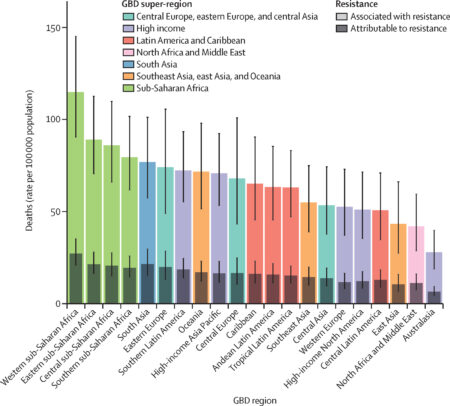AMR kills more people than malaria and HIV
A study published on 19 January 2022 in The Lancet estimates that 4.95 million deaths could be associated with bacterial AMR in 2019, including 1.27 million deaths attributable to bacterial AMR. According to the researchers this indicates that bacterial AMR is a health problem whose magnitude is at least as large as major diseases such as HIV and malaria, and potentially much larger.
The study, ‘Global burden of bacterial antimicrobial resistance in 2019: a systematic analysis’, found the all-age death rate attributable to resistance to be highest in western sub-Saharan Africa, at 27.3 deaths per 100,000 people, and lowest in Australasia, at 6.5 deaths per 100,000. Lower respiratory infections accounted for more than 1.5 million deaths associated with resistance in 2019, making it the most burdensome infectious syndrome.

All-age rate of deaths attributable to and associated with bacterial antimicrobial resistance by GBD region, 2019
Moreover, as the Access to Medicine Foundation puts it, the most vulnerable populations in the world do not have access to the antibiotics and antifungals they need, while they are also most vulnerable to drug-resistant infections. The Foundation’s latest report of 9 June 2022, ‘Lack of access to medicine is a major driver of drug resistance. How can pharma take action?’, presents ways for pharmaceutical companies to improve local availability of specific medicines. Key takeaways from this study include a focus on appropriate access – antibiotics and antifungals need to be available, while also making sure they are being used responsibly so they stay effective for as long as possible; six new case studies from Cipla, Pfizer, Sanofi, Shionogi and Viatris, in India, Ghana, Nigeria and South Africa; and a broad range of tools available for companies to increase access to essential antibiotics and antifungals in poorer nations, such as wider product registration, technology transfers, and public-private partnerships.


 Report
Report
